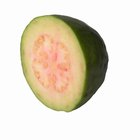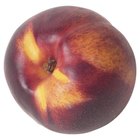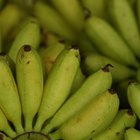Lefthand666/iStock/GettyImages
Fruit peelings frequently get tossed out with the trash or added to the compost pile. But edible peels contain vitamins and minerals, antioxidants and fiber -- sometimes even more than the fruit's flesh. Used purposefully, peelings can provide flavor and add nutrition to many different dishes. While it’s always important to wash fruit before you eat it, it’s even more important when you eat the peel, which can retain the largest concentration of dirt and chemicals.
Pome Fruits
It's common to eat the skin of pome fruits, such as apples, pears and quince. The thin peels boost the flavor of many foods, such as muffins and smoothies. You can brew the peels for tea. Apple peelings are also a natural source of pectin, the substance that thickens jellies and jams.
Citrus Fruits
Citrus fruits, such as lemons and limes, are used throughout the world for their acidic flesh. You can also eat the outer rind, or colored portion of the peel, although the pith, or white layer between the rind and fruit, is bitter and inedible. Citrus peels can be added fresh as zest, the finely grated outer rind, or dried and candied for use in food and drinks such as marmalade and tea. They add a zesty twist to everything from cheesecake to cider. Citrus fruits include lemons, limes, oranges, grapefruits, tangelos and tangerines.
Watermelon
Watermelon rinds can be pickled to give them a pleasant flavor and crunch. Peel off the colored outer skin and soak the inner rind in brine to pickle it. You can enjoy the pickled rind alone or pair it with other ingredients, such as in a salad.
Stone Fruit
Stone fruits such as peaches have flesh that surrounds a single large seed. The skins on stone fruits are thin and edible, with a flavor that is either slightly tart or sometimes imperceptible. Though the skin typically gets eaten with the flesh when the fruit is consumed whole, the peelings get discarded in many jam and canning recipes. However, leaving the peelings on adds a flavorful boost of nutrients to the dish.
Stone fruits include peaches, apricots, nectarines, plums, mangoes and cherries. There are many ways to prepare skin-on stone fruits, from grilled for a sweet dessert to blended for a healthy smoothie. Tasty dishes that use the fruit with the skin on include salsas, marmalade, breads and pies.
Other Fruits
Many fruits have edible peelings that are thrown away due to taste and texture rather than safety concerns. For example, banana peels are safe to eat but rarely consumed due to their taste and texture. You can also eat the peelings of kiwi and papaya, although they're often discarded because of their texture.
Fruits with truly inedible peelings include pomegranates and pineapples.
Related Articles

How Much Fiber Is in Fresh Figs?

How to Cook Papaya

How to Juice Pineapple Skin

What Are the Benefits of Persimmons?

Can You Eat Clementines With the Peel?

How to Boil Beetroot

Peeling the Spiny Chayote Squash
How to Eat Asian Pears

How to Eat a Quince

How to Freeze a Prickly Pear Cactus

Foods From Rainforest Plants

How to Eat a Kiwano Horned Melon

How to Peel Guava

How to Bake Nectarines Like Peaches

List of Tropical Fruits

How to Keep Pomegranate Fresh

The History of Butternut Squash
How to Freeze Papaya

Candied Fruit for Baking
Can You Eat Ginger Peel?
References
- The Deluxe Food Lover's Companion: Sharon Tyler Herbst and Ron Herbst
- Women’s Health Magazine: Food Tips That Aren’t Skin Deep
- Popular Science: Pectin: Not Just For Jelly
- Purdue University: Banana
Writer Bio
A writer since 2000, Aya Pauli has covered a variety of topics including food, fashion, beauty, health, parenting, education, decor and crafts. Her award-winning recipes have been published in food magazines such as "Taste of Home," and she is also the author of a salad cookbook. Pauli's craft projects appear in major manufacturer websites, including Dow Styrofoam. She also holds a CDA in early childhood education and works as a preschool teacher in Wyoming.